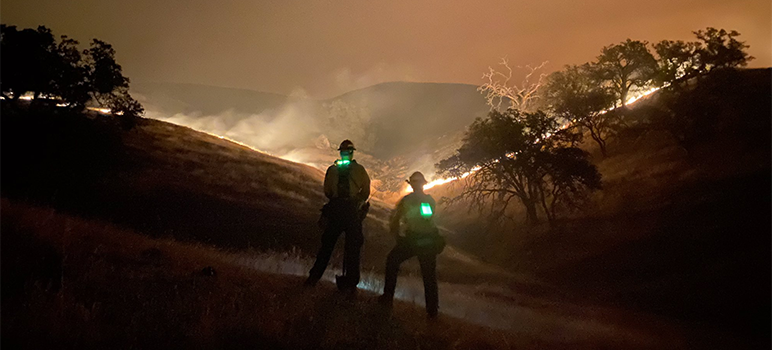A few-hundred lightning bolts last night ignited some small fires throughout the region.
But the tropical storm cells that brought scattered rain from the Central Coast to Santa Cruz Mountains paled in comparison to last week’s frenzy of 11,000 strikes, which sparked hundreds of blazes that have since become some of largest fires in state history.
Officials said the influx in moisture at least helped slow some of the fiery onslaught while winds fanned away enough smoke for air support to target water drops.
AIR OPERATIONS: We have several helicopters making water drops over the #CZULightningComplex and eyes above them to make sure the pilots and crew are safe! pic.twitter.com/Cb64mkrcEd
— CAL FIRE CZU (@CALFIRECZU) August 24, 2020
Still, fires raging all around Santa Clara Valley continue to close in.
To the east of San Jose, the SCU Complex grew from a sparsely populated expanse in five counties to seven, prompting additional evacuations in Fremont, Sunol and Livermore to the north and below the Anderson Reservoir in Morgan Hill to the south.
Though mandatory evacuations stopped short of San Jose’s Evergreen neighborhood, city officials urged residents to pack their bags just in case.
Click here for Cal Fire’s map of evacuation zones.
By this morning, the SCU cluster of fires surpassed 347,196 acres, according to Cal Fire, with 10 percent containment. The SCU fires—spanning from San Jose city limits along Mt. Hamilton to within a few miles of the I-5 in the Central Valley—have destroyed a dozen buildings, damaged as many more and hurt two civilians and three firefighters.
CA FIRES UPDATE:
- Over 13,000 lightning strikes
- 625 fires
- 17 major fires, including some of largest in CA history
- Over 1.2 million acres burned (nearly size of Grand Canyon)Thank you to all the states that have offered mutual aid to help CA battle these historic fires.
— Gavin Newsom (@GavinNewsom) August 24, 2020
Thankfully, overnight electrical storms mostly skipped the SCU Complex, officials said.
“We did have minimal lightning strikes,” Cal Fire spokesman Capt. James Amador told San Jose Inside in a phone call today. “One started a half-acre fire in the Pacheco Peak area ... but we anticipated more, so we got ready for a lot more than we actually saw.”
The 1,300-plus firefighters working the SCU blazes remain on high alert, however.
“We’re not out of the woods yet,” said Amador, a veteran San Diego firefighter staffing Cal Fire’s SCU Complex media hotline.
With the skies clearing and storm cells dissipating, however, the National Weather Service lifted a red flag “fire watch” warning initially expected to last through tonight.
Meanwhile, air quality has improved in and around San Jose from “unhealthy” on Sunday to “moderate” this morning. According to the U.S. Air Quality Index, that means it’s safe to breathe for “most people.”
We have CANCELLED the Red Flag Warning.
Stay weather aware as weak cells are still over the North Bay; however, most moisture has moved north of our area and instability has decreased giving us confidence to let the warning expire early.#CAwx pic.twitter.com/bG8PKPr6Sn
— NWS Bay Area (@NWSBayArea) August 24, 2020
Though the weather eased up, the fires have not.
To the south and west of San Jose, the CZU Complex claimed its first casualty: a 70-year-old man trapped by the flames near Davenport.
The 78,000-acre fires, which are now 13 percent contained, have demolished 176 homes and threaten to destroy 25,000 more in Santa Cruz and San Mateo counties, per Cal Fire. The state firefighting agency said to expect an uptick in the official tally of destroyed structures as inspection teams survey the damage.
Cal Fire reported some progress over the weekend, however, thanks to mild weather that allowed them to construct defensive lines get better overhead views to map perimeters.
“Firefighters worked aggressively overnight taking suppression action on the CZU Lightning Complex,” Cal Fire wrote in a 7am update. “Fire danger remains elevated and everyone should continue to use extreme caution.”
Heavy timber and thick undergrowth have fueled the flames roaring through the coastal mountain range as erratic winds make their course unpredictable.
More than 70,000 people had already fled the CZU blazes when Cal Fire on Sunday night expanded evacuation orders beyond the Santa Clara County line.
And yet, “fire activity may dictate more evacuations and road closures in the days to come,” the state firefighting agency cautioned.
In the North Bay’s wine country, the 350,000-acre LNU Complex holds steady as the biggest fire now burning in California and the second-biggest in state history.
Cal Fire has managed to control 22 percent of the LNU fires, which have claimed three lives, incinerated more than 870 buildings and damaged 234 others.
Strong gusts, lightning and erratic flames have crews bracing for additional fire growth in Napa, Sonoma and Solano counties, where some evacuation orders have been lifted.
Cal Fire said it will livestream a press conference at 11am with updates on the LNU fires. A presser on the SCU Complex is set for 3pm and will be broadcast here.

